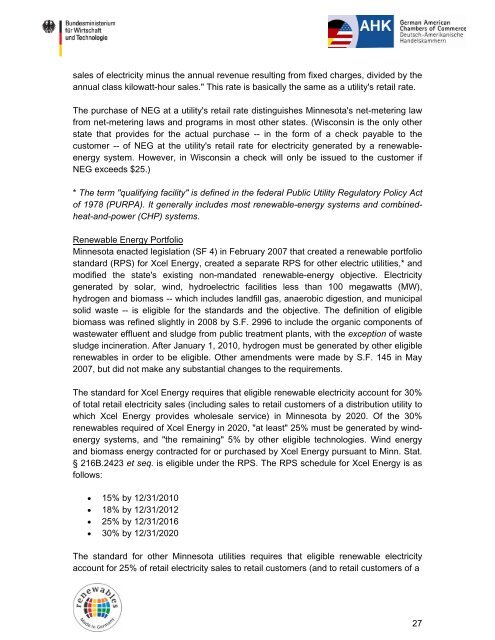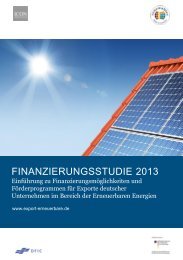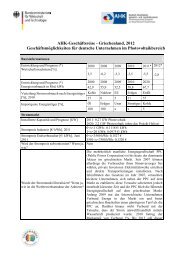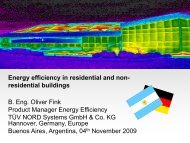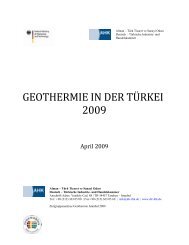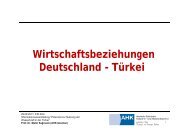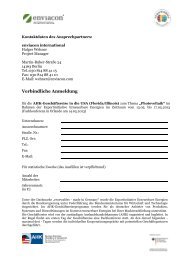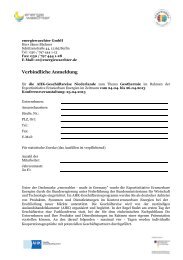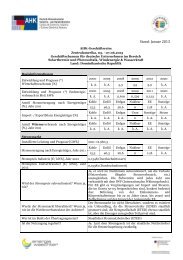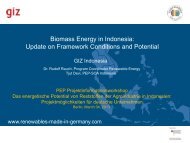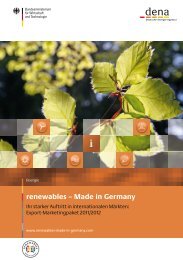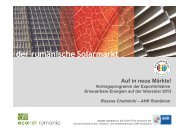PDF: 1,1 MB - Exportinitiative Erneuerbare Energien
PDF: 1,1 MB - Exportinitiative Erneuerbare Energien
PDF: 1,1 MB - Exportinitiative Erneuerbare Energien
- No tags were found...
You also want an ePaper? Increase the reach of your titles
YUMPU automatically turns print PDFs into web optimized ePapers that Google loves.
sales of electricity minus the annual revenue resulting from fixed charges, divided by the<br />
annual class kilowatt-hour sales." This rate is basically the same as a utility's retail rate.<br />
The purchase of NEG at a utility's retail rate distinguishes Minnesota's net-metering law<br />
from net-metering laws and programs in most other states. (Wisconsin is the only other<br />
state that provides for the actual purchase -- in the form of a check payable to the<br />
customer -- of NEG at the utility's retail rate for electricity generated by a renewableenergy<br />
system. However, in Wisconsin a check will only be issued to the customer if<br />
NEG exceeds $25.)<br />
* The term "qualifying facility" is defined in the federal Public Utility Regulatory Policy Act<br />
of 1978 (PURPA). It generally includes most renewable-energy systems and combinedheat-and-power<br />
(CHP) systems.<br />
Renewable Energy Portfolio<br />
Minnesota enacted legislation (SF 4) in February 2007 that created a renewable portfolio<br />
standard (RPS) for Xcel Energy, created a separate RPS for other electric utilities,* and<br />
modified the state's existing non-mandated renewable-energy objective. Electricity<br />
generated by solar, wind, hydroelectric facilities less than 100 megawatts (MW),<br />
hydrogen and biomass -- which includes landfill gas, anaerobic digestion, and municipal<br />
solid waste -- is eligible for the standards and the objective. The definition of eligible<br />
biomass was refined slightly in 2008 by S.F. 2996 to include the organic components of<br />
wastewater effluent and sludge from public treatment plants, with the exception of waste<br />
sludge incineration. After January 1, 2010, hydrogen must be generated by other eligible<br />
renewables in order to be eligible. Other amendments were made by S.F. 145 in May<br />
2007, but did not make any substantial changes to the requirements.<br />
The standard for Xcel Energy requires that eligible renewable electricity account for 30%<br />
of total retail electricity sales (including sales to retail customers of a distribution utility to<br />
which Xcel Energy provides wholesale service) in Minnesota by 2020. Of the 30%<br />
renewables required of Xcel Energy in 2020, "at least" 25% must be generated by windenergy<br />
systems, and "the remaining" 5% by other eligible technologies. Wind energy<br />
and biomass energy contracted for or purchased by Xcel Energy pursuant to Minn. Stat.<br />
§ 216B.2423 et seq. is eligible under the RPS. The RPS schedule for Xcel Energy is as<br />
follows:<br />
15% by 12/31/2010<br />
18% by 12/31/2012<br />
25% by 12/31/2016<br />
30% by 12/31/2020<br />
The standard for other Minnesota utilities requires that eligible renewable electricity<br />
account for 25% of retail electricity sales to retail customers (and to retail customers of a<br />
27


